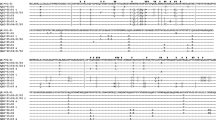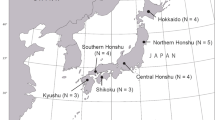Abstract
The largest remaining carnivorous marsupial, the Tasmanian devil (Sarcophilus harrisii), is currently under threat of extinction due to a fatal contagious cancer—devil facial tumour disease. Low major histocompatibility complex (MHC) class I diversity is believed to have contributed to the transmission of the tumour allograft through devil populations. Here, we report low MHC class II variability in this species, with DA β chain genes (Saha-DAB1, 2 and 3) exhibiting very limited diversity and the sole α chain gene (Saha-DAA) monomorphic. Three, six and three alleles were found at Saha-DAB1, 2 and 3, respectively, with a predominant allele found at each locus. Heterozygosity at these three loci is low in the eastern population and modestly higher in northwestern individuals. The results are indicative of a selective sweep likely due to an infectious disease resulting in the fixation of selectively favoured alleles and depletion of genetic diversity at devil class II loci. Several attempts were made to isolate the other marsupial classical class II gene family, namely, DB, resulting in only one DBB pseudogene being found. These findings further support the view that this species has a compromised capacity to respond to pathogen evolution, emerging infectious diseases and environmental changes.





Similar content being viewed by others
References
Belov K, Lam MKP, Hellman L, Colgan DJ (2003) Evolution of the major histocompatibility complex: isolation of class II beta cDNAs from two monotremes, the platypus and the short-beaked echidna. Immunogenetics 55:402–411
Belov K, Deakin JE, Papenfuss AT et al (2006) Reconstructing an ancestral mammalian immune supercomplex from a marsupial major histocompatibility complex. PLoS Biol 4:e46
Beveridge I, Spratt DM (2003) Parasites of carnivorous marsupials. In: Jones M, Dickman CR, Archer M (eds) Predators with pouches: the biology of carnivorous marsupials. CSIRO, Melbourne
Bondinas GP, Moustakas AK, Papadopoulos GK (2007) The spectrum of HLA-DQ and HLA-DR alleles, 2006: a listing correlating sequence and structure with function. Immunogenetics 59:539–553
Brown JH, Jardetzky TS, Gorga JC et al (1993) Three-dimensional structure of the human class II histocompatibility antigen HLA-DR1. Nature 364:33–39
Cheng Y, Siddle HV, Beck S, Eldridge MDB, Belov K (2009) High levels of genetic variation at MHC class II DBB loci in the tammar wallaby (Macropus eugenii). Immunogenetics 61:111–118
Cheng Y, Stuart A, Morris K et al. (2012) BAC-contig-based characterization of MHC Class I and Class II regions in the Tasmanian devil (Sarcophilus harrisii). BMC Genom 13:87
Chu Z-TE, Carswell-Crumpton C, Cole BC, Jones PP (1994) The minimal polymorphism of class II Eα chains is not due to the functional neutrality of mutations. Immunogenetics 40:9–20
de Groot NG, Otting N, Doxiadis GGM et al (2002) Evidence for an ancient selective sweep in the MHC class I gene repertoire of chimpanzees. Proc Natl Acad Sci 99:11748–11753
de Groot NG, Heijmans CMC, de Groot N et al (2008) Pinpointing a selective sweep to the chimpanzee MHC class I region by comparative genomics. Mol Ecol 17:2074–2088
Edwards SV, Potts WK (1996) Polymorphism of genes in the major histocompatibility complex: implications for conservation genetics of vertebrates. In: Smith TB, Wayne RK (eds) Molecular genetic approaches in conservation. Oxford University Press, Oxford
Felsenstein J (1985) Confidence limits on phylogenies: an approach using the bootstrap. Evolution 39:783–791
Frank SA (2002) Immunology and evolution of infectious disease. Princeton University Press, Princeton
Goudet J (2001) FSTAT, a program to estimate and test gene diversities and fixation indices (version 2.9.3). Available from http://www.unil.ch/izea/softwares/fstat.html. Updated from Goudet (1995)
Goudet J, Raymond M, de Meeüs T, Rousset F (1996) Testing differentiation in diploid populations. Genetics 144:1933–1940
Hall T (1999) Bioedit: a user friendly biological sequence alignment editor and analysis program for windows 95/98/NT. Nucleic Acids Symp Ser 41:95–98
Hamede R, McCallum H, Jones ME (2008) Seasonal, demographic and density-related patterns of contact between Tasmanian devils: implications for transmission of devil facial tumour disease. Austral Ecol 33:614–622
Hawkins CE, Baars C, Hesterman H et al (2006) Emerging disease and population decline of an island endemic, the Tasmanian devil Sarcophilus harrisii. Biol Conserv 131:307–324
Ho CS, Lunney JK, Ando A et al (2009) Nomenclature for factors of the SLA system, update 2008. Tissue Antigens 73:307–315
Holland OJ, Cowan PE, Gleeson DM, Chamley LW (2008a) High variability in the MHC class II DA beta chain of the brushtail possum (Trichosurus vulpecula). Immunogenetics 60:775–781
Holland OJ, Cowan PE, Gleeson DM, Chamley LW (2008b) Novel alleles in classical major histocompatibility complex class II loci of the brushtail possum (Trichosurus vulpecula). Immunogenetics 60:449–460
Holz PH (2008) Dasyurids. In: Vogelnest E, Woods R (eds) Medicine of Australian mammals. CSIRO, Melbourne
Hughes AL (1999) Adaptive evolution of genes and genomes. Oxford University Press, New York
Janeway CA, Travers P, Walport M, Shlomchik M (2001) Immunobiology: the immune system in health and disease. Garland, New York
Jones ME, Paetkau D, Geffen E, Moritz C (2004) Genetic diversity and population structure of Tasmanian devils, the largest marsupial carnivore. Mol Ecol 13:2197–2209
Kalinowski ST, Taper ML, Marshall TC (2007) Revising how the computer program cervus accommodates genotyping error increases success in paternity assignment. Mol Ecol 16:1099–1106
Kirsch JAW, Lapointe F-J, Springer MS (1997) DNA-hybridisation studies of marsupials and their implications for Metatherian classification. Aust J Zool 45:211–280
Lachish S, Miller KJ, Storfer A, Goldizen AW, Jones ME (2011) Evidence that disease-induced population decline changes genetic structure and alters dispersal patterns in the Tasmanian devil. Heredity 106:172–182
McCallum H, Jones M, Hawkins C et al (2009) Transmisson dynamics of Tasmanian devil facial tumor disease may lead to disease-induced extinction. Ecology 90:3379–3392
Meyer-Lucht Y, Otten C, Puttker T, Sommer S (2008) Selection, diversity and evolutionary patterns of the MHC class II DAB in free-ranging Neotropical marsupials. BMC Genet 9:39
Miller W, Hayes VM, Ratan A et al (2011) Genetic diversity and population structure of the endangered marsupial Sarcophilus harrisii (Tasmanian devil). Proc Natl Acad Sci 108:12348–12353
Murchison EP, Tovar C, Hsu A et al (2010) The Tasmanian devil transcriptome reveals Schwann cell origins of a clonally transmissible cancer. Science 327:84–87
Nei M, Kumar S (2000) Synonymous and nonsynonymous nucleotide substitutions. In: Molecular evolution and phylogenetics. Oxford University Press, New York
O’Brien S, Evermann J (1988) Interactive influence of infectious disease and genetic diversity in natural populations. Trends Ecol Evol 3:254–259
Paddle R (2000) The last Tasmanian tiger: the history and extinction of the Thylacine. Cambridge University Press, Melbourne
Paddle R (2012) The thylacine’s last straw: epidemic disease in a recent mammalian extinction. Aust Zool, in press
Pearse AM, Swift K (2006) Allograft theory: transmission of devil facial-tumour disease. Nature 439:549
Rocha N, Neefjes J (2008) MHC class II molecules on the move for successful antigen presentation. EMBO J 27:1–5
Saitou N, Nei M (1987) The neighbor-joining method: a new method for reconstructing phylogenetic trees. Mol Biol Evol 4:406–425
Siddle HV, Sanderson C, Belov K (2007) Characterization of major histocompatibility complex class I and class II genes from the Tasmanian devil (Sarcophilus harrisii). Immunogenetics 59:753–760
Siddle HV, Marzec J, Cheng Y, Jones M, Belov K (2010) MHC gene copy number variation in Tasmanian devils: implications for the spread of a contagious cancer. Proc R Soc B 277:2001–2006
Siddle H, Deakin J, Coggill P et al (2011) The tammar wallaby major histocompatibility complex shows evidence of past genomic instability. BMC Genomics 12:421
Spratt DM, Beveridge I, Walter EL (1991) A catalogue of Australasian monotremes and marsupials and their recorded helminth parasites. In: Jones PG, Horton P, Mathews EG, Thurmer J (eds) Records of the South Australian Museum. Monograph series 1. South Australian Museum, Adelaide
Stone WH, Bruun DA, Fuqua C et al (1999) Identification and sequence analysis of an Mhc class II B gene in a marsupial (Monodelphis domestica). Immunogenetics 49:461–463
Tamura K, Dudley J, Nei M, Kumar S (2007) MEGA4: Molecular Evolutionary Genetics Analysis (MEGA) software version 4.0. Mol Biol Evol. doi:10.1093/molbev/msm1092
Wagner J, Burnett R, Storb R (1999) Organization of the canine major histocompatibility complex: current perspectives. J Hered 90:35–38
Weir BS, Cockerham CC (1984) Estimating F-statistics for the analysis of population structure. Evolution 38:1358–1370
Yuhki N, O’Brien S (1997) Nature and origin of polymorphism in feline MHC class II DRA and DRB genes. J Immunol 158:2822–2833
Yuhki N, Beck T, Stephens RM, Nishigaki Y, Newmann K, O’Brien SJ (2003) Comparative genome organization of human, murine, and feline MHC class II region. Genome Res 13:1169–1179
Acknowledgments
This work was funded by the Australian Research Council. KB and MJ are supported by ARC Future Fellowships. YC is supported by an Endeavour International Postgraduate Research Scholarship. We thank Rodrigo Hamede and Shelley Lachish at the University of Tasmania for sample collection.
Author information
Authors and Affiliations
Corresponding author
Electronic supplementary material
Below is the link to the electronic supplementary material.
S1
Genotype data of 60 Tasmanian devils at MHC Class II loci (PDF 43 kb)
Rights and permissions
About this article
Cite this article
Cheng, Y., Sanderson, C., Jones, M. et al. Low MHC class II diversity in the Tasmanian devil (Sarcophilus harrisii). Immunogenetics 64, 525–533 (2012). https://doi.org/10.1007/s00251-012-0614-4
Received:
Accepted:
Published:
Issue Date:
DOI: https://doi.org/10.1007/s00251-012-0614-4




